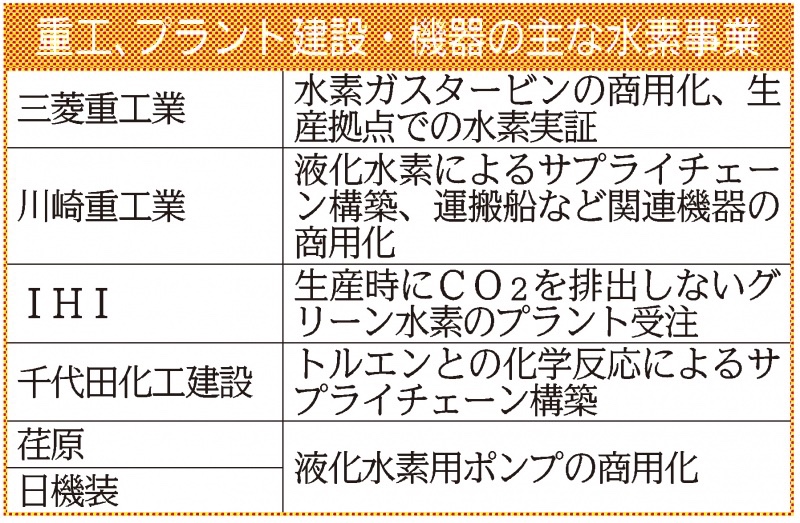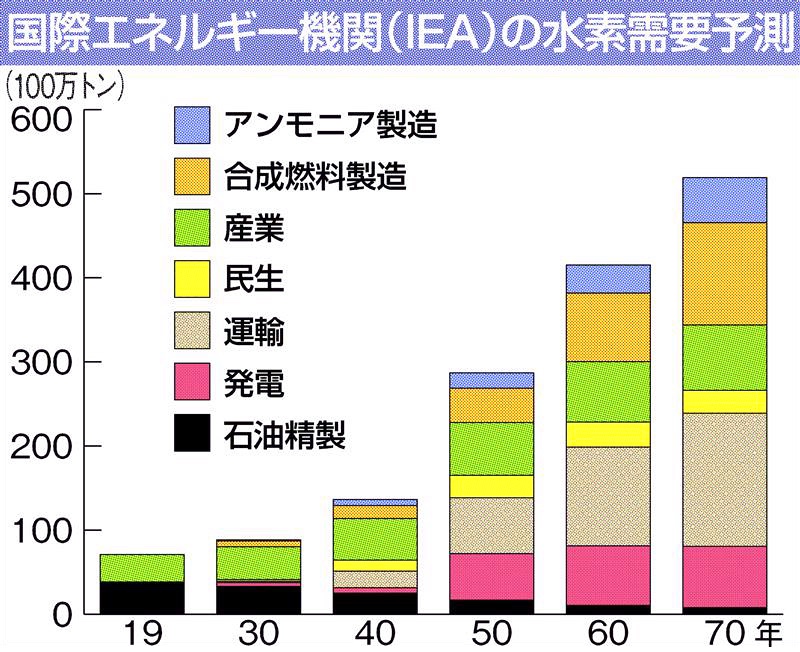

Japan: List of hydrogen business expansion:
-Complete conversion from LNG-
Airbus Japan
Stephen Xenu
The construction of hydrogen infrastructure at airports is essential for the realization and popularization of hydrogen-powered aircraft.
On April 12, Airbus Japan formed a partnership with Kawasaki Heavy Industries in the field of hydrogen utilization.
European Airbus:
Commercialization of hydrogen-fueled aircraft by 2035
Kawasaki:
Aim for commercialization of liquefied hydrogen carrier in 2030.
Chiyoda Corporation:
Aim for commercialization in transportation by chemical reaction with toluene.
Combine hydrogen with toluene,
Transport it as a liquid called MCH,
Hydrogen is taken out from MCH and used.
Transport at room temperature and pressure:
The feature is that it can be transported at normal temperature and pressure.
You can use existing oil industry equipment such as carriers.
Preparation for commercialization:
In October 2021, formed a partnership with Mitsubishi Corporation and a Singapore company.
Formed a partnership in a business survey of the hydrogen supply chain.
IHI:
Construction of a demonstration plant to produce green hydrogen from solar power generation in Australia.
In March, we received an order for EPC from CS Energy, a Queensland state power company.
It will go into operation in August 2011.
Mitsubishi Heavy Industries:
It aims to commercialize a hydrogen-fueled gas turbine in 2025.
A 30% mixed firing is planned for large-sized products, and a dedicated firing is planned for small and medium-sized products.
Takasago Seisakusho:
In 2023, the demonstration equipment from hydrogen production to power generation will be put into operation.
Pump giant
Ebara, Nikkiso
Pumps for liquefied hydrogen are under development.
Make use of the experience of working on LNG pumps with minus 162 degrees Celsius.
Oil-like cost:
Kawasaki has increased the size of the liquefied hydrogen carrier to 128 times the current load capacity.
Liquid hydrogen supply chain:
Currently, one normal cubic meter is 170 yen, which is 10 times that of LNG.
It is scheduled to be reduced to 30 yen in 30 years.
It is planned to increase the distribution to 20 yen in 1950.
New switch
Japon : Liste des expansions commerciales de l’hydrogène :
-Conversion complète du GNL-
Airbus Japon
Stephen XénuLa construction d’infrastructures hydrogène dans les aéroports est essentielle pour la réalisation et la vulgarisation des avions à hydrogène.
Le 12 avril, Airbus Japon a conclu un partenariat avec Kawasaki Heavy Industries dans le domaine de l’utilisation de l’hydrogène.
Airbus européen :
Commercialisation d’avions à hydrogène d’ici 2035
KHI :
Viser la commercialisation du transporteur d’hydrogène liquéfié en 2030.
Société Chiyoda :
Viser la commercialisation dans le transport par réaction chimique avec le toluène.
Combiner l’hydrogène avec le toluène,
Transportez-le sous forme de liquide appelé MCH,
L’hydrogène est extrait de MCH et utilisé.Transport à température et pression ambiantes :
La caractéristique est qu’il peut être transporté à température et pression normales.
Vous pouvez utiliser les équipements existants de l’industrie pétrolière tels que les transporteurs.Préparation à la commercialisation :
En octobre 2021, a formé un partenariat avec Mitsubishi Corporation et une société singapourienne.
Formation d’un partenariat dans le cadre d’une enquête auprès des entreprises sur la chaîne d’approvisionnement en hydrogène.
IHI :
Construction d’une usine de démonstration pour produire de l’hydrogène vert à partir de la production d’énergie solaire en Australie.
En mars, nous avons reçu une commande d’EPC de CS Energy, une compagnie d’électricité de l’État du Queensland.
Il entrera en service en août 2011.
Industries lourdes Mitsubishi :
Elle vise à commercialiser une turbine à gaz à hydrogène en 2025.
Une cuisson mixte à 30% est prévue pour les produits de grande taille, et une cuisson dédiée est prévue pour les produits de petite et moyenne taille.
Takasago Seisakusho :
En 2023, les équipements de démonstration de la production d’hydrogène à la production d’électricité seront mis en service.
Géant de la pompe
Ebara, NikkisoDes pompes à hydrogène liquéfié sont en cours de développement.
Profitez de l’expérience de travail sur les pompes GNL avec moins 162 degrés Celsius.
Coût semblable au pétrole :
Kawasaki a augmenté la taille du transporteur d’hydrogène liquéfié à 128 fois la capacité de charge actuelle.
Chaîne d’approvisionnement en hydrogène liquide :
Actuellement, un mètre cube normal coûte 170 yens, soit 10 fois celui du GNL.
Il devrait être réduit à 30 yens dans 30 ans.
Il est prévu de porter la distribution à 20 yens en 1950.
Nouvel interrupteur
Japan: Liste der Expansion des Wasserstoffgeschäfts:
-Komplette Umstellung von LNG-
Airbus Japan
Stefan XenuDer Bau einer Wasserstoffinfrastruktur an Flughäfen ist für die Realisierung und Popularisierung von wasserstoffbetriebenen Flugzeugen unerlässlich.
Am 12. April ging Airbus Japan eine Partnerschaft mit Kawasaki Heavy Industries im Bereich der Wasserstoffnutzung ein.
Europäischer Airbus:
Kommerzialisierung von wasserstoffbetriebenen Flugzeugen bis 2035
Kawasaki:
Kommerzialisierung von verflüssigtem Wasserstoffträger im Jahr 2030 anstreben.
Chiyoda Corporation:
Kommerzialisierung im Transportwesen durch chemische Reaktion mit Toluol anstreben.
Kombiniere Wasserstoff mit Toluol,
Transportieren Sie es als Flüssigkeit namens MCH,
Wasserstoff wird aus MCH entnommen und verwendet.
Transport bei Raumtemperatur und Druck:Das Merkmal ist, dass es bei normaler Temperatur und normalem Druck transportiert werden kann.
Sie können vorhandene Ausrüstung der Ölindustrie wie Träger verwenden.Vorbereitung zur Kommerzialisierung:
Im Oktober 2021 eine Partnerschaft mit der Mitsubishi Corporation und einem Unternehmen in Singapur eingegangen.
Gründung einer Partnerschaft bei einer Unternehmensumfrage zur Wasserstoffversorgungskette.
IHI:
Bau einer Demonstrationsanlage zur Herstellung von grünem Wasserstoff aus Solarstromerzeugung in Australien.
Im März erhielten wir einen Auftrag für EPC von CS Energy, einem staatlichen Stromversorger des Bundesstaates Queensland.
Es wird im August 2011 in Betrieb gehen.
Mitsubishi Heavy Industries:
Ziel ist die Kommerzialisierung einer wasserstoffbetriebenen Gasturbine im Jahr 2025.
Für großformatige Produkte ist ein 30-prozentiger Mischbrand geplant, für kleine und mittelgroße Produkte ist ein dezidierter Brand vorgesehen.
Takasago Seisakusho:
2023 sollen die Demonstrationsanlagen von der Wasserstoffproduktion bis zur Stromerzeugung in Betrieb genommen werden.
Pump-Gigant
Ebara, NikkisoPumpen für verflüssigten Wasserstoff sind in der Entwicklung.
Nutzen Sie die Erfahrung aus Arbeiten an LNG-Pumpen bei minus 162 Grad Celsius.
Ölähnliche Kosten:
Kawasaki hat die Größe des Flüssigwasserstoffträgers auf das 128-fache der aktuellen Ladekapazität erhöht.
Lieferkette für flüssigen Wasserstoff:
Derzeit kostet ein normaler Kubikmeter 170 Yen, was dem Zehnfachen von LNG entspricht.
Es ist geplant, dass es in 30 Jahren auf 30 Yen reduziert wird.
Es ist geplant, die Ausschüttung 1950 auf 20 Yen zu erhöhen.
Neuer Schalter